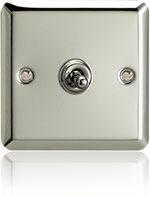In electrical installations a switch is an electrical component that can break an electrical circuit, interrupting the current or diverting it from one conductor to another. The most familiar form of switch is a manually operated electromechanical device with one or more sets of electrical contacts. Each set of contacts can be in one of two states: either 'closed' meaning the contacts are touching and electricity can flow between them, or 'open', meaning the contacts are separated. |  |
 | A switch may be directly manipulated by a human as a control signal to a system, such as to control power flow in a circuit, as in a light switch, or to isolate a supply, such as a Firemans switch. Automatically-operated switches can be used to control the motions of machines, for example, to indicate that a garage door has reached its full open position or that a machine tool is in a position to accept another work piece. Switches may be operated by process variables such as pressure, temperature, flow, current, voltage, and force, acting as sensors in a process and used to automatically control a system. For example, a thermostat is a temperature-operated switch used to control a heating process. A switch that is operated by another electrical circuit is called a relay. Large switches may be remotely operated by a motor drive mechanism. Some switches are used to isolate electric power from a system, providing a visible point of isolation that can be pad-locked if necessary to prevent accidental operation of a machine during maintenance, or to prevent electric shock. |
N/O & N/C Switches
In a push-button type switch, in which the contacts remain in one state unless actuated, the contacts can either be normally open (abbreviated "n.o." or "no") until closed by operation of the switch, or normally closed ("n.c. or "nc") and opened by the switch action. A switch with both types of contact is called a changeover switch. These may be "make-before-break" which momentarily connect both circuits, or may be "break-before-make" which interrupts one circuit before closing the other. Examples of NC Switches include Fire & Intruder Alarms, Emergency Lighting, a Fridge Light or a Walk-In wardrobe...
The following lists the common (and not so common) switches you may encounter or require:
| Type of Switch | Circuit Symbol | Example |
ON-OFF A simple on-off switch. This type can be used to switch the power supply to a circuit. When used with mains electricity this type of switch must be in the live wire, but it is better to use a DPST switch to isolate both live and neutral. |  SPST toggle switch | |
(ON)-OFF A push-to-make switch returns to its normally open (off) position when you release the button, this is shown by the brackets around ON. This is the standard doorbell switch. |  Push-to-make switch | |
ON-(OFF) A push-to-break switch returns to its normally closed (on) position when you release the button (N/C) such as a fridge door. |  Push-to-break switch | |
ON-ON This switch can be on in both positions, switching on a separate device in each case. It is often called a changeover switch. For example, a SPDT switch can be used to switch on a red lamp in one position and a green lamp in the other position. A SPDT toggle switch may be used as a simple on-off switch by connecting to COM and one of the A or B terminals shown in the diagram. A and B are interchangeable so switches are usually not labelled. |  |  SPDT toggle switch  SPDT slide switch |
Dual ON-OFF A pair of on-off switches which operate together (shown by the dotted line in the circuit symbol). A DPST switch is often used to switch mains electricity because it can isolate both the live and neutral connections. |  |  DPST rocker switch |
Dual ON-ON A pair of on-on switches which operate together (shown by the dotted line in the circuit symbol). ON-OFF-ON A special version of the standard SPDT switch. It has a third switching position in the centre which is off. This can be very useful for motor control because you have forward, off and reverse positions. Momentary (ON)-OFF-(ON) versions are also available where the switch returns to the central off position when released. |  |  DPDT slide switch  Wiring for Reversing Switch |
Unusual Switches: Micro-switch (usually SPDT = ON-ON) |  |
Unique Key-switch A key operated switch. The example shown is SPST. |  |
Tilt Switch (SPST) Tilt switches contain a conductive liquid and when tilted this bridges the contacts inside, closing the switch. They can be used as a sensor to detect the position of an object. Some tilt switches contain mercury which is poisonous. |  |
Reed Switch (usually SPST) |  |
DIP Switch (DIP = Dual In-line Parallel) This is a set of miniature SPST on-off switches, the example shown has 8 switches. The package is the same size as a standard DIL (Dual In-Line) integrated circuit. This type of switch is used to set up circuits, e.g. setting the code of a remote control. |  |
Dimmer switches A dimmer switch contains a solid-state circuit to allow changing the brightness by reducing the average voltage applied to the lamp. With lighting design it is worth remembering, if a single pole, one-way switch is used, the lighting scheme has two options, ‘ON’ or ‘OFF’. Introduce a simple dimmer and the options multiply existentially... break the circuits up and introduce a multiple dimmer, and the scheme has endless alternative. |  |

